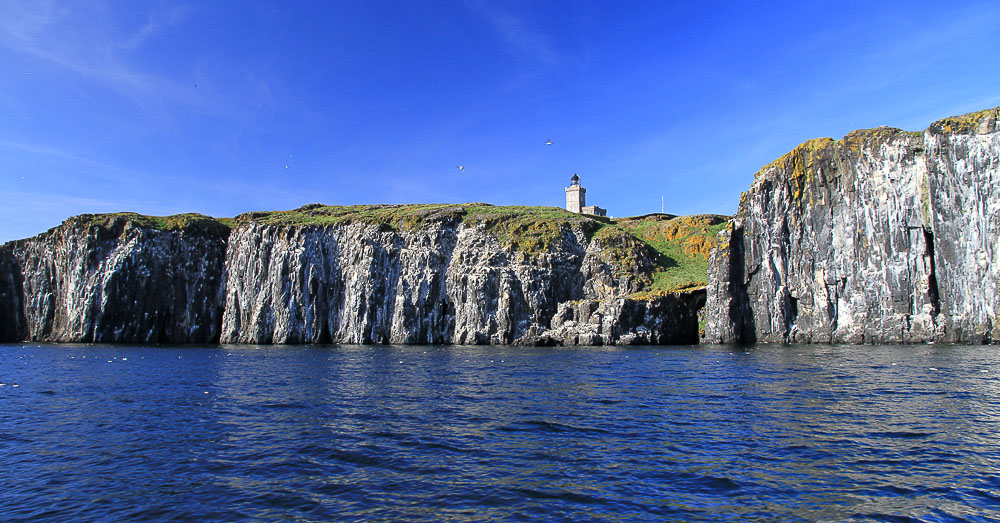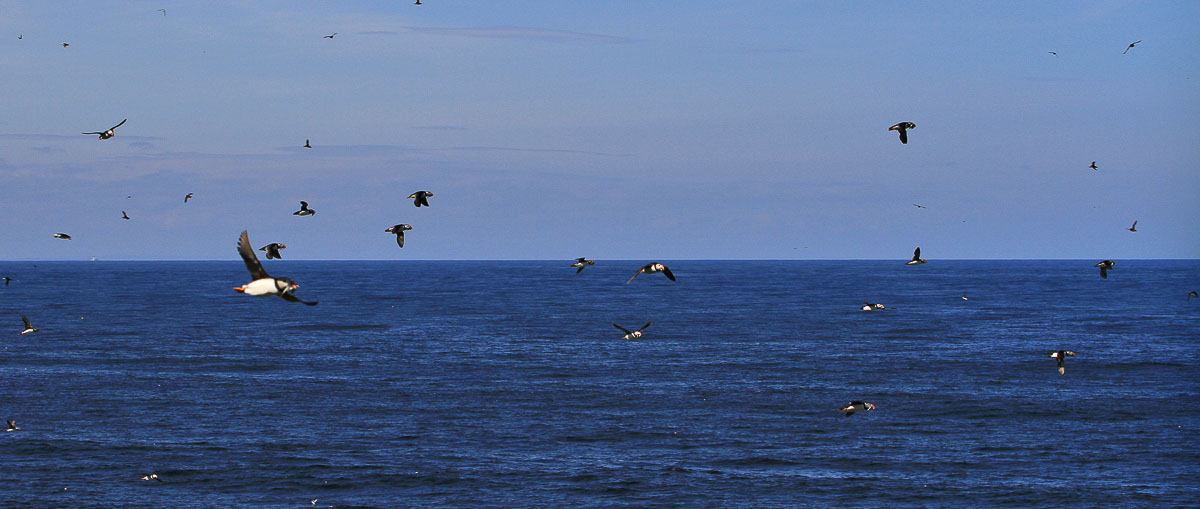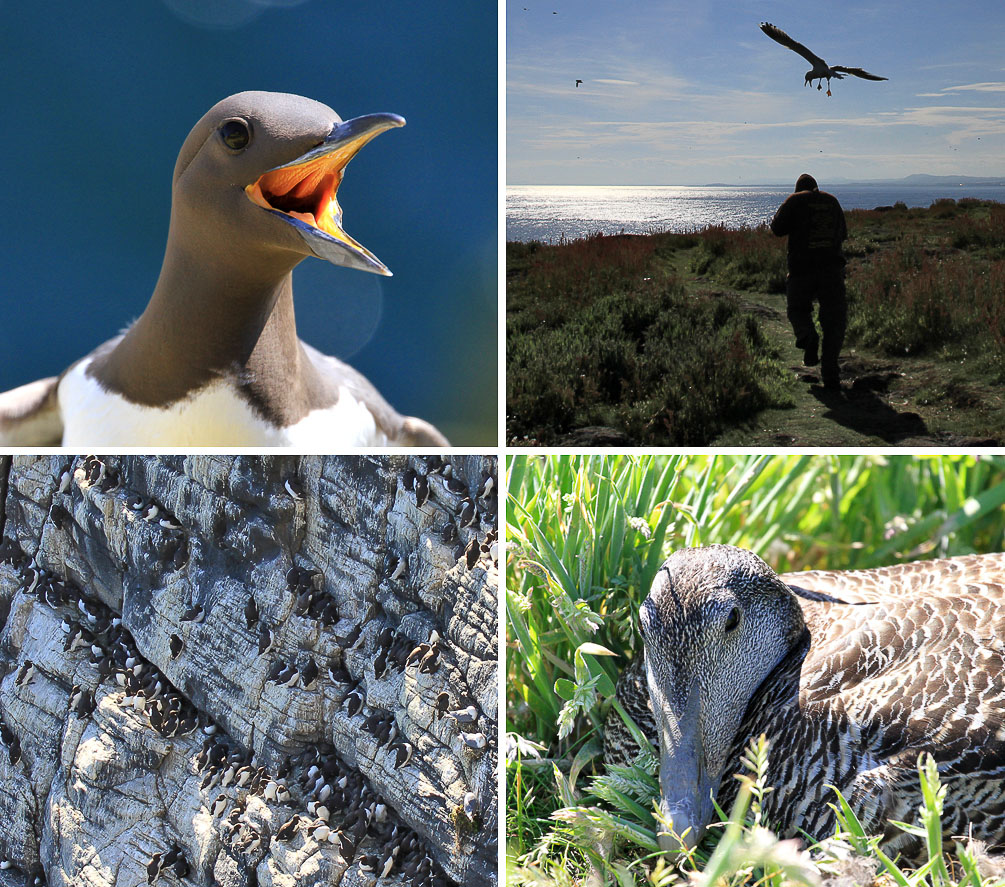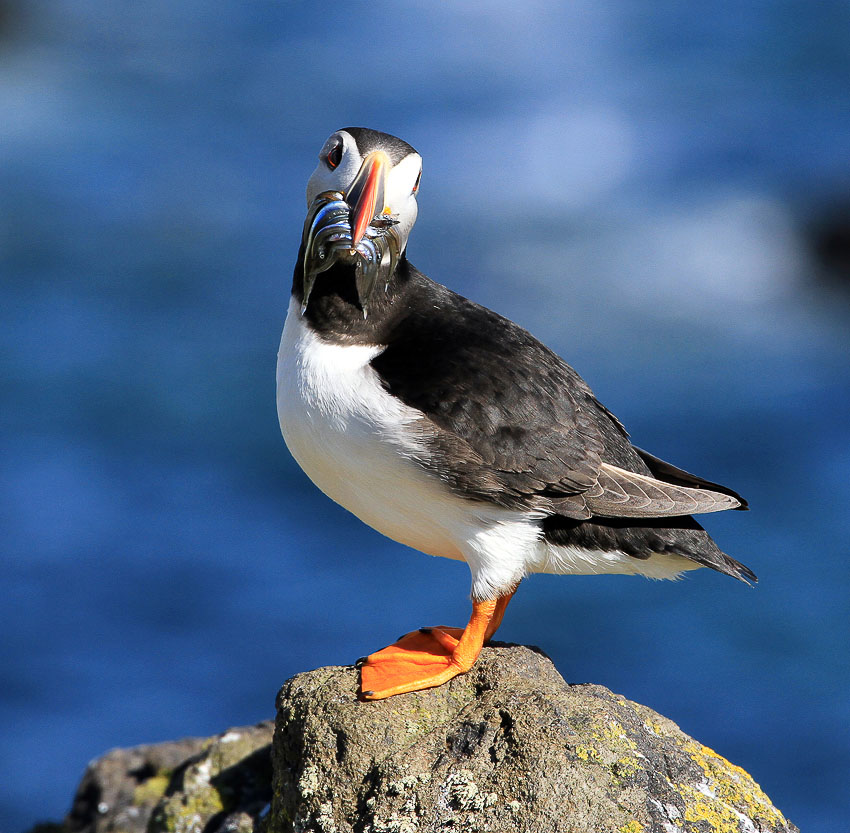
The Jewel of the Forth
An island measuring 1500 by 500 metres mightn’t be the first place that springs to mind when you’re looking for an afternoon’s cliff-top walking or one of the greatest natural spectacles in the British Isles, but stick with me.
With its imposingly sheer cliffs, solitary panoramic location and enormous expansive views of the Forth estuary, the Isle of May is well worth visiting for its modest walking potential alone. But if that wasn’t enough, the island is also blessed with an outrageous abundance of seabirds.
Seen from the industrial Fife coast or from Edinburgh, where the view is one of docks, cranes, apartments and ships, it seems wildly unlikely that such abundance could eke out an existence in the spaces in between.
But against such odds a staggering 200,000 birds call this modest rock home during the summer months. So too do thousands of seals that breed on the Isle of May every autumn. In terms of natural heritage this really is as good as it gets.
Small wonder the island is decorated to the gills with the most prestigious European wildlife designations. And all within sight of Scotland’s capital.
Lying a mere five miles off the Fife coast, ‘The May’ is hardly St Kilda but, like many an island, access is granted only by the good graces of the weather gods.
That’s partly why I’d never visited the island. Another reason I’d never visited was because it’s so close to home. I’ve lived in Fife for years but it’s one of those silly situations where a place is so close I keep putting it off in favour of farther flung places. More exotic places.
Last month I set out to change that. But there was only one reason I was visiting and I didn’t try to convince myself otherwise.
Puffins!
There’s something about puffins
I find all birds intriguing and a pleasure to watch, but some have developed a weird celebrity status that somehow lifts them above the rest. The puffin is one such bird.
There could be any number of reasons for this. It could be because it is so easy to identify, with its huge orange beak and striking black & white plumage. It could be its clown-like appearance although, personally speaking, anything looking vaguely clown-like makes me run a mile.
Whatever the reason, we do seem to reserve a special place in our hearts for the puffin. Only last week Alison Steadman was on the telly in Shetland, gushing about seeing her first ever puffin at Sumburgh Head and saying how it had fulfilled a lifelong ambition.
A cynic might have called it overly melodramatic to see Alison visibly moved by her encounter on that windswept headland, but I (and doubtless many others) certainly understood what it meant to her.
In 30 or so years of trying to see puffins up close, the only ones I’d ever seen were tiny wee things whizzing past the Small Isles ferry with their wings flapping like their lives depended on it. The photos I took were woeful. Blurred black specks set against a rolling sea.
They certainly weren’t the puffin photos I’d always imagined myself taking. I know it’s a cliché and I know it’s predictable but I’d always wanted THAT photo. The photo that EVERYONE tries to get when they head out to a puffin colony.
A close-up of a puffin, orange beak blazing, clutching a beakful of sand eels. The perfect puffin.
The May in June
It’s not surprising most of us have never seen a puffin up close. They’re numerous around our coastline but their population is concentrated in a handful of far-flung locations. And even in those places you won’t see them all year round.
Puffins spend the autumn and winter out at sea, only returning to dry land to breed or, if not yet of breeding age, suss out future breeding sites. They do that between March and August.
They nest underground in metre-long burrows and, by June, those burrows have been excavated or reoccupied, the chicks have hatched, and the parents are frantically toing and froing with beakfuls of fish for their young.
Summer is therefore an excellent time to spot puffins and, as the largest colony in the North Sea with a space-defying 46,000 burrows, the Isle of May is one of the best places to do so.
So, as I stood at the quayside in Anstruther on what was easily the best weather day of the summer so far, to say I was excited would be an understatement.
The sailing took 50 minutes and after a slightly unsettling manoeuvre where we ploughed through enormous surf to access the sheltered jetty, we alighted and were met by one of the resident Scottish Natural Heritage (SNH) wardens.
We were also met by some irate terns that nest around the landing spot.
The warden gave us a nice introduction to the island, a list of do’s & don’t’s, and we were then speedily ushered up through the tern colony…..all the while being divebombed, pecked and pooed on by terns. Those of us with hoods, hats or umbrellas were the more fortunate ones.
We were then left to our own devices for a couple of hours.
Argy-bargy
The walking was surprisingly steep in places. Some of it was on surfaced tracks but most of it was on grass paths steered between the colonies of birds. Every now and then we’d pass a female eider on her nest, beautifully camouflaged and barely noticeable just inches from the path.
Keeping to the paths is of vital importance to prevent hapless visitors from putting their feet through a puffin burrow or crushing chicks under foot. However, even by sticking to the paths you’re likely to incur the wrath of nearby nesting birds.
Enormous gulls rose up from their nests and harassed and harangued any passers-by, encouraging them to quicken their pace. Amusing as it was to watch these interactions, the comedy belied the gravity of the situation.
This wasn’t cute, cuddly Nature viewed from a distance. This was elbow-bashing, in-your-face Nature. Overcrowded, argumentative Nature where animals jostle with one another for space and resources, fending off any perceived threats.
Breeding season is make-or-break for the natural world and, on the Isle of May, that fact is rudely and sharply brought home. SNH, who own and manage the island are acutely aware of this, which is why sailing times and visitor numbers are strictly managed.
A vortex of puffins
Unsurprisingly, the thing you can’t help but notice when you visit the island is how the sky above your head is absolutely teeming with birds.
They were zooming past both high and low, from every direction. Often I’d hear them before I saw them, the furious flapping of wings announcing yet another lightning flypast.
It was such a jumble that I couldn’t focus on any one bird. It was like watching the masses swarm over Princes St in Edinburgh on a Saturday; the faces and appearance of individuals in the crowd completely lost in the bigger picture of a busy, jostling mass.
Everything in my field of vision was moving. It was unrelenting, astonishing, but it’s funny how quickly I accepted it as the norm.
I’d actually walked a good ten minutes before I realised that the vast majority of the individuals making up that busy jostling mass were puffins. Not tens, not hundreds, but thousands of them. It was impossible to single out one section of the sky as being more full of puffins than another, so congested was the airspace over the island.
And yet there was a definite order to it. The returning birds, beaks full of fish, came arcing inland in graceful curves along the same general flight path, but when viewed all together it was like an enormous swirling vortex above me.
I had to keep reminding myself that this was the tiny bird that had eluded me for three decades. Until that day the most I’d seen in one place was two, but now, still within sight of home, there were thousands and it was utterly joyous. Overwhelming.
It was impossible not to stop, stand and stare with an open jaw.
They’re so small!
Eventually I found a pair of puffins sitting on a cliff top a few metres from the path. As I sat snapping away with my camera at the perfectly posed puffins, I could hear exclamations of surprise from other people nearby.
‘They’re so small!’
Ask anyone how big a puffin is and they’ll probably imagine something penguin sized. But puffins are indeed surprisingly small at only 20-30cm in height. Watching these beautiful wee things standing there it was incredible to think what hardships they endure.
Once the chicks fledge and leave the island they spend years out at sea, taking the very worst of what the open water can throw at them. Incredibly, despite those hardships some puffins can reach the ripe old age of 20. One bird in the Farne Islands is apparently 32!
I sat near the puffins, smiling in the sunshine as I listened to their ‘muted chainsaw’ purring, before finally managing to tear myself away. I spent what little time I had left peering over the highest cliffs at the loud, raucous ‘bird city’ below.
Thousands of guillemots and razorbills nested on the narrowest ledges in gravity-defying fashion. Shags lined up on the lowest rocks below while gulls and fulmars wheeled overhead.
There was so much more to see but I’d run out of time. That everything else had played second fiddle was the inevitable result of having a star attraction. A bit like visiting Paris for the first time and realising on your last day that you’ve seen the Eiffel Tower and nothing else. One visit is rarely enough.
As I ran the gauntlet of terns back to the boat, I knew I’d be back to savour everything else the island has to offer.
And as for THAT photo……..did I get it? Oh yes!
Where to see Scotland’s puffins
Ben went to the Isle of May, off the coast of Fife. There are regular summer boat trips available from Anstruther, and from North Berwick in East Lothian. From North Berwick you can also see puffins more distantly on Craigleith, visited by boat trips (no landings) to the Bass Rock.
Other great puffin-watching locations around Scotland include:
The Treshnish Isles – regular boat trips available from the Isle of Mull
Castle o’ Burrian on Westray, Orkney (a few puffins may also be seen at the Brough of Birsay or Marwick Head)
Dun Mor, Sanday – linked to Canna in the Small Isles
Handa Island, Sutherland
Bullars of Buchan and Troup Head, Aberdeenshire
More far-flung possibilities: St Kilda, Fair Isle, Foula, Sumburgh Head in Shetland.




